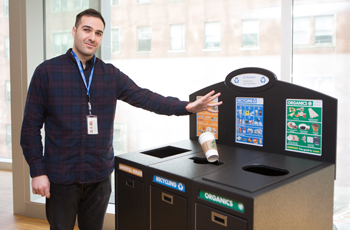Recycling in the LKSKI: Know before you throw

By Greg Winson

Anthony Yannos, a digital project co-ordinator in Research Facilities, recycles his Starbucks coffee cup. (Photo by Katie Cooper)
You’ve enjoyed your morning Starbucks. Now it’s time to dispose of your cup. But do you discard your cup in the recycling bin or the waste bin?
In the Li Ka Shing Knowledge Institute, that empty cup belongs in the recycling bin.
“Most people think that coffee cups are not recyclable items, as the City of Toronto classifies these materials as waste,” said Anthony Yannos, a digital project co-ordinator in Research Facilities. “However, GFL, who manages our waste collection, deems these items as recyclable.”
Subway and other soft drink cups are a different story. Most soft drink cups contain a wax lining, which means they can’t be recycled, and should be deposited in the waste bin.
Research Facilities has also worked with GFL to introduce composting into the LKSKI. The new bins allow anyone in the LKSKI to compost their organic waste just like they do at home.
Composting in workplace settings lags behind efforts to compost at home, according to a CBC story. More than 50 per cent of food waste at home is diverted from landfill in Ontario, while only 25 per cent of food waste from industrial, commercial and institutional sectors is diverted.
What types of organic waste should go into the LKSKI composting bins?
|
Composting bins are located in common areas of the LKSKI alongside recycling and waste bins. Posters fitted above the bin show the types of organic waste that should be sorted for composting.
“We have seen a steady increase in the use of the composting bins since the program started in December,” said Yannos.
Composting bins are also located in areas of the hospital where food is prepared and served, including the Marketeria.
Recycling efforts at the Li Ka Shing Knowledge Institute pre-date the building itself. Ninety-eight per cent of materials from the buildings demolished to make way for the LKSKI were recycled, adding up to 1,760 truckloads of excavated materials. The LKSKI itself was designed for energy conservation with two layers of glass: one to encase the building, along with a series of glass fins to cool the facility, especially in summer.
St. Michael’s has earned several accolades for its energy and waste conservation, including the Green Hospital of the Year Award for 2016.
About St. Michael’s Hospital
St. Michael’s Hospital provides compassionate care to all who enter its doors. The hospital also provides outstanding medical education to future health care professionals in more than 29 academic disciplines. Critical care and trauma, heart disease, neurosurgery, diabetes, cancer care, care of the homeless and global health are among the Hospital’s recognized areas of expertise. Through the Keenan Research Centre and the Li Ka Shing International Healthcare Education Centre, which make up the Li Ka Shing Knowledge Institute, research and education at St. Michael’s Hospital are recognized and make an impact around the world. Founded in 1892, the hospital is fully affiliated with the University of Toronto.
